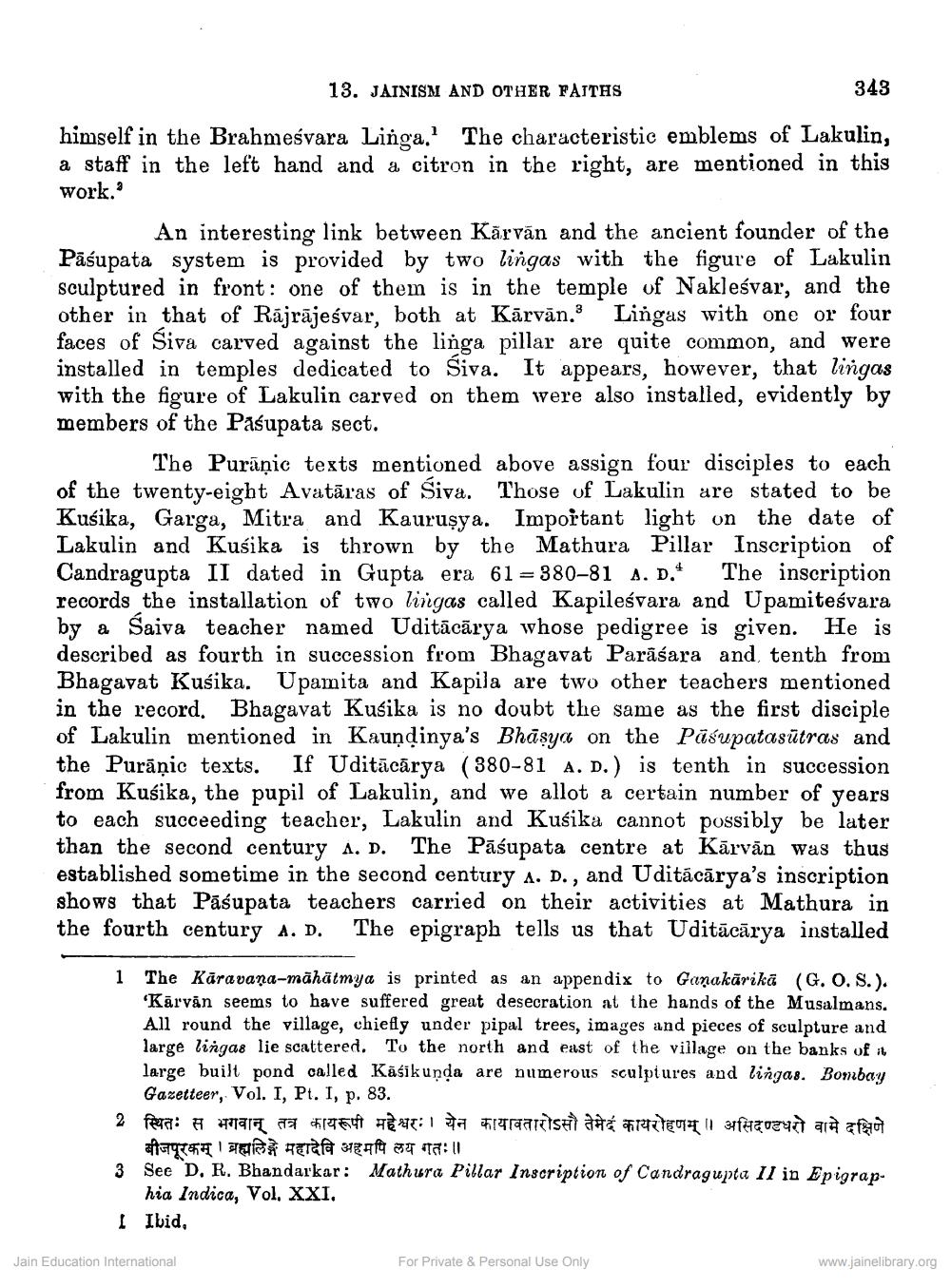________________
13. JAINISM AND OTHER FAITHS
himself in the Brahmeśvara Linga.' The characteristic emblems of Lakulin, a staff in the left hand and a citron in the right, are mentioned in this work."
343
An interesting link between Kärvän and the ancient founder of the Pasupata system is provided by two lingas with the figure of Lakulin sculptured in front: one of them is in the temple of Naklesvar, and the other in that of Rajrajeśvar, both at Karvan.3 Lingas with one or four faces of Siva carved against the linga pillar are quite common, and were installed in temples dedicated to Siva. It appears, however, that lingas with the figure of Lakulin carved on them were also installed, evidently by members of the Pasupata sect.
The Puranic texts mentioned above assign four disciples to each of the twenty-eight Avataras of Śiva. Those of Lakulin are stated to be Kusika, Garga, Mitra and Kaurusya. Important light on the date of Lakulin and Kusika is thrown by the Mathura Pillar Inscription of Candragupta II dated in Gupta era 61-380-81 A. D.* The inscription records the installation of two lingas called Kapileśvara and Upamitesvara by a Saiva teacher named Uditācārya whose pedigree is given. He is described as fourth in succession from Bhagavat Parāśara and tenth from Bhagavat Kusika. Upamita and Kapila are two other teachers mentioned in the record. Bhagavat Kusika is no doubt the same as the first disciple of Lakulin mentioned in Kaunḍinya's Bhasya on the Pasupatasūtras and the Puranic texts. If Uditācārya (380-81 A. D.) is tenth in succession from Kusika, the pupil of Lakulin, and we allot a certain number of years to each succeeding teacher, Lakulin and Kusika cannot possibly be later than the second century A. D. The Pasupata centre at Karvan was thus established sometime in the second century A. D., and Uditācārya's inscription shows that Pasupata teachers carried on their activities at Mathura in the fourth century A. D. The epigraph tells us that Uditācārya installed
1 The Karavana-māhātmya is printed as an appendix to Ganakārikā (G. O. S.). 'Kārvān seems to have suffered great desecration at the hands of the Musalmans. All round the village, chiefly under pipal trees, images and pieces of sculpture and large lingas lie scattered. To the north and east of the village on the banks of t large built pond called Kasikunda are numerous sculptures and lingas. Bombay Gazetteer, Vol. I, Pt. I, p. 83.
2 स्थितः स भगवान् तत्र कायरूपी महेश्वरः । येन कायावतारोऽसौ तेमेद कायरोहणम् || असिदण्डधरो वामे दक्षिणे बीजपूरकम् | ब्रह्मलिङ्गे महादेवि अहमपि लय गतः ॥
3 See D. R. Bhandarkar: Mathura Pillar Inscription of Candragupta II in Epigraphia Indica, Vol. XXI.
I Ibid.
Jain Education International
For Private & Personal Use Only
www.jainelibrary.org




